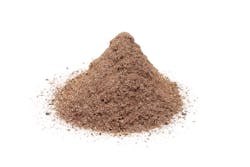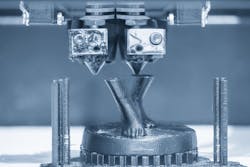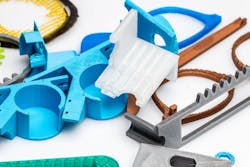Can Additive Manufacturing Deliver the Materials You Need?
If you’ve avoided thinking about additive manufacturing for fear of fixing what isn’t broken, you’re not wrong. Additive opens up an entirely new realm of possibilities and, depending on your point of view, a Pandora’s Box as well, raising questions and challenging assumptions you might be perfectly happy to leave undisturbed if your plant and business are churning along comfortably and profitably.
Comfort level with existing material choices is a big reason not to look into additive. To be frank, it is unlikely you’ll keep using the same plastics you’ve always used because they probably don’t work in additive machines. But those same plastics also might force you to manufacture heavier or more complicated parts than you actually need to manufacture.
And then the question comes down to who figures out first, you or your competitors, why it’s worth revisiting your material choices and designs if it’s possible for your product.
The first consideration is a big one, however. Your materials are long since qualified and you know darned well the quality metrics of the parts manufactured from those materials. The first step to considering additive is wrapping your head around the materials questions. Below are the answers.
Can I Use the Same Injection Molding Material That’s Worked for 30 Years?
Probably not, but do you really need to?
Demand typically drives new additive material development. Marty Johnson, vice president of product and technical fellow at 3D Systems, asks potential customers to name the three most important properties for the part they want to manufacture. The information allows 3D Systems’ Application Innovation Group to figure out whether an existing formulation works for the task or could be tweaked.
“Generally, we’re close enough now that we’ve got a good spread of materials. A lot of times, we’re not looking at tweaks as much because… we’re in that range of [what properties] we need to be able to hit,” says Johnson.
François Minec, global head of polymers, 3D printing at HP, notes that the number of available choices depends on what type of additive manufacturing we’re talking about.
“In injection molding, there may be hundreds of thousands of different formulations. On our HP printer at the moment there are six types of [plastic] materials, PA (polyamide) 11, PA 12, PA 12 with glass, two types of TPU (thermoplastic polyurethane), PP (polypropylene). It’s much more complex to develop,” Minec says.
Hugo da Silva, VP of strategy, M&A and venturing at Stratasys, confirms the comparatively limited number of plastic materials for injection molding vs. additive manufacturing. However, existing material portfolios can provide versatility.
“[Take] a PBT (polybutylene terephthalate) with 10% glass fiber. PBT can be translated to PBT with no glass fiber because we are able to bend the design a bit or change slightly the way we process the material in the printer. Maybe we will [use] PA 12 with carbon fiber rather than glass fiber. The answer is not straightforward,” da Silva says.
Additive manufacturers sometimes find it difficult to convince customers to accept material substitutions even if properties like hardness, toughness and chemical resistance remain roughly the same. But, to stick with plastics, the manufacturing process in a 3D printer is fundamentally different than the process of an injection molding machine and the original material might not work at all for additive.
3D Systems shows potential customers data sheets on all the materials in its portfolio and the maximum properties those materials can achieve, using standard industry test results. Johnson says customers get a chance to “say no, fast.”
“We try to give enough information up front. The end user is always responsible for their product testing. But what we’ve tried to do is break that barrier from guesswork from an injection molded material and get that bridge where they can go do the product testing with some confidence in what they’re going to come out with, so that it’s more efficient time-wise and more economic financially for them to run those tests, because some of those tests [take] months,” says Johnson.
How Long Will It Take to Tweak a Material?
Well, it depends on how many critical properties you need.
If an additive manufacturer doesn’t have the right material for a use case, tweaking a formulation that comes close often provides the best option. If you need your parts on a short timeframe, a tweak might take more time than you have.
The type of additive material determines whether formulations may be adjusted. According to Minec, liquid materials don’t get tweaked. Specific formulations mimic traditional materials. Formulations for filament or powder materials are adjustable. Filament material adjustments may take months to complete and powders even more time.
“You need to develop the base resin, you need to grind it and then test it on the printer. You add some additives before compounding, add some additives after grinding it. You might do other treatments [so] the powder normally takes much longer,” says Minec.
Johnson says additive manufacturers have large portfolios of resins because they are easier to manipulate and a much smaller portfolio of powders. For materials meant for material jetting processes, where liquid binds powder particles (binder jetting) or ultraviolet light cures droplets to bind the material (material jetting), matching the required properties with the desired color is challenging.
“It’s not just dropping in a little dye. … The chemistry can be similar in color changes, but now we [have] to go through that print process method [that] really has to change to get those best properties back out of that material,” says Johnson.
The actual process of tweaking a material generally may only take between three and six months, says da Silva, but that’s not where the waiting time really lies: Tweaked materials must run the qualification gauntlet just like entirely new materials.
Is It Easier Just to Develop Something New for Me?
Almost certainly not, and the material won’t be just for you, but it could give you precisely what you’re looking for.
If no tweak to an existing material works for the use case, additive manufacturers may create something entirely new. Whether or not they invest the significant time and money required to do so depends almost entirely on the potential for new applications beyond the immediate use case.
New materials developed for automotive parts that must handle high in-cabin temperatures, for example, may also make good material options for electronics parts. Materials developed with high flame retardant properties for automotive also might work for aerospace parts.
Testing time for entirely new materials could take much longer than for tweaked materials because additive manufacturers must dial in the brand new formulations. Sometimes people get lucky, says Johnson, but otherwise new material development may take twelve to eighteen months. Regulatory needs, if the new material will go into medical parts, for example, also adds to the development timeline.
Additive manufacturers have options when developing new chemistries and don’t know which formulations will come closest to matching the target properties. And even when materials tests on solid samples demonstrate the right tolerances, the new material must then test on all the different types of relevant additive manufacturing processes and possibly on all the different machines in which the material might be used, says da Silva.
Speaking strictly to his expertise in polymers, Minec says new materials adequate for test parts may take six months on average, but developing stable, repeatable materials takes much longer.
“Our customers don’t want to be test dummies, so when we bring a new material to the [market] it has been tested and re-tested over and over [until] it’s a really extremely robust solution,” Minec says.
On the extreme end, creating new materials for dental applications (one of the biggest additive markets) can take five to ten years, says da Silva.
“That’s absolutely a challenge and a lot of that’s because you’re mixing the biocompatible properties with the mechanical properties with the visual properties that all come together into one,” says Johnson.
Manufacturers generally ought not to expect proprietary rights on any new materials developed on their behalf. The times and expense of new material development makes the proposition of proprietary use extremely unattractive to additive manufacturers in all but the rarest cases.
Custom Materials Take Time and Money. Is There Another Choice?
Design for manufacturing can settle material questions very quickly.
Revisiting part design to take advantage of the unique architectures offered by additive manufacturing may obviate the need to consider materials outside existing portfolios. In fact, additive manufacturers often argue that replicating parts manufactured by traditional methods might miss the point of going with additive manufacturing in the first place.
“[We may say to a customer] ‘Are you able to explore a design change…[or] a material modification that will deliver the properties you’re looking for in that specific part? … Maybe you can combine two or three parts and make it even more economically viable.’ I think the lack of knowledge on how to develop products under additive manufacturing is the number one reason why it fails,” says da Silva.
Minec gives the specific example of customers not wanting to use materials with very high toughness to create cushioning in footwear and asking for new materials with less hardness but also less resiliency.
“Actually, we can solve this by designing a very fine lattice which may [feel like softer materials] but has the same mechanical properties [as the more resilient material],” says Minec.
Johnson says that after prospective customers share the three most important properties of the building material they want, 3D Systems then assesses desired performance properties of the part itself, like long term stability, indoor or outdoor use, repeated or single use, etc.
“You go in and start looking at how that part is designed. And if I’m using an injection mold where I can only make this part this way and I’ve got these big heavy cross sections and things like that, well I may not need to do a material change at all. We can go in there and start making mechanical changes and changes in the geometry and achieve that application I was trying to get, with one of the materials in hand,” Johnson says.
About the Author
Dennis Scimeca
Dennis Scimeca is a veteran technology journalist with particular experience in vision system technology, machine learning/artificial intelligence, and augmented/mixed/virtual reality (XR), with bylines in consumer, developer, and B2B outlets.
At IndustryWeek, he covers the competitive advantages gained by manufacturers that deploy proven technologies. If you would like to share your story with IndustryWeek, please contact Dennis at [email protected].





